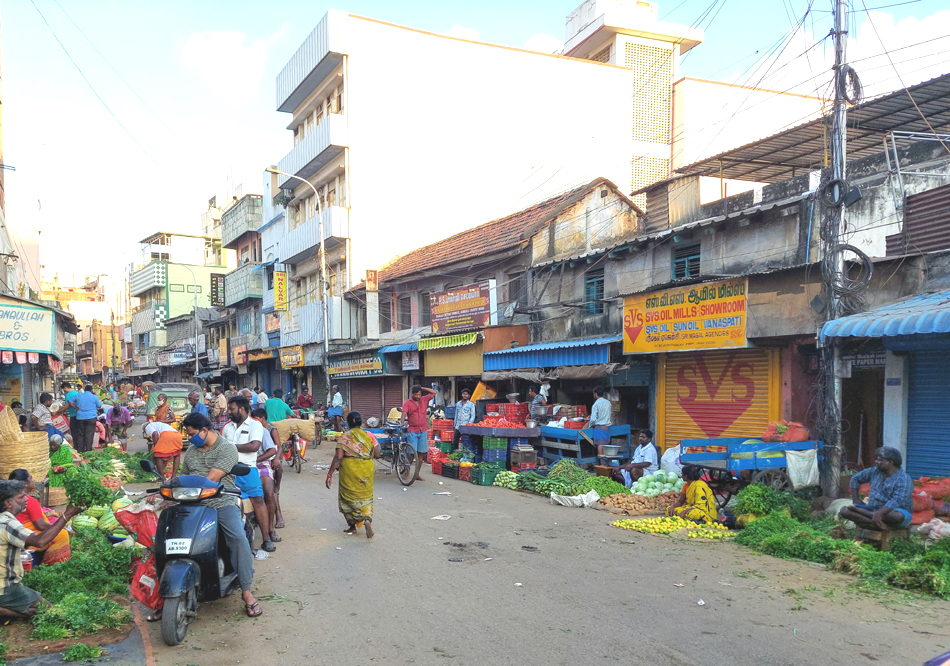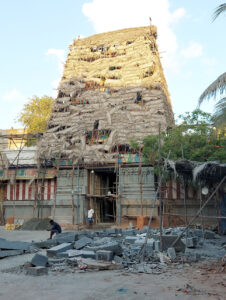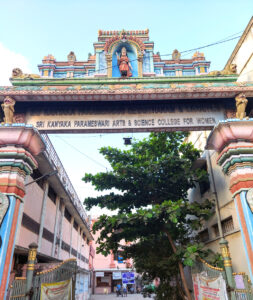Registered with the Registrar of Newspapers for India under R.N.I 53640/91
Vol. XXX No. 22, March 16-31, 2021
Lost Landmarks of Chennai
- Sriram V
From Kotwal Chavadi to Koyambedu

Audiappa Street where the market once stood.
To the present generation, buying of anything and everything is a touch of the phone. This was already the prevalent attitude even before the pandemic and it has only been reinforced since, especially when the lockdown forced most people to go online to shop even for vegetables. Who then would bother with the larger markets such as Thaneer Thurai or Panagal Park or Esplanade? It is no wonder that almost all of them have vanished. Even the city’s wholesale market for vegetables, at Koyambedu, is a place that we have only read of but never visited. Therefore it follows that its predecessor, at Kotwal Chavadi, is a hazy memory at best. Sometimes it is best that it remains so for none who has visited the place can ever forget the chaos, the stench and the absolute filth. But there can be no denying that it fulfilled a vital function for Madras for over 200 years before it was wound up in 1996.

The Sri Kanyaka Parameswari temple undergoing restoration.
To get a clear picture of how the market began, we need to turn to my dear friend, the late Prof Mattison Mines, who was for long a regular visitor to Madras and above all, an authority on the Arya Vysya aka Komatti Chetty community. Matt, as Mr. Muthiah referred to him, and he very graciously extended the same privilege to me too, wrote Public Faces, Private Voices – Community and Individuality in South India (University of California Press, 1994), which in my view is the seminal work on the subject of the business communities of George Town. This article of mine refers to this work and also to an article he wrote titled Temples and Charity, The neighbourhood styles of the Komati and Beeri Chettiar Merchants of Madras City for the compilation The Meaning of Local, the Politics of Place in Urban India (de Neeve and Donner (ed), UCL Press, 2011).
To the uninitiated, Kotwal Chavadi (literally the square of the Kotwal or Chief Inspector), was in the heart of George Town and eventually came to define the place. Many people in fact used the two names interchangeably. But in reality, the market was a private space, owned by the Sri Kanyaka Parameswari Devasthanam (SKPD) Charities. As the name implies, it was connected with the worship of the tutelary deity of the Arya Vysyas – Kanyaka Parameswari. But its growth had much to do with the local politics of the late 1700s. Originally named the Kooragaya Komatla Thotta (literally the vegetable garden of the Komatis), it was in existence as early as in 1708 when as per Matt, a property’s boundary was mentioned as being the Komatla Thotta. He also notes that it features prominently in maps of Madras made in 1733 and 1755. Dedicated to the “general body of the Vysya caste people for the performance of the festivals, ceremonies and charities of the caste” it was held in trust by the headman, who in the 1790s was Sunku Krishnamma Chetty. Succeeding him was Colla Muthurama Chetty, who in 1803 collected funds via donations and built a shrine for the goddess at a corner of the garden. This was probably his way of securing the property for the community for in 1790, the East India Company had confiscated the space under the mistaken assumption that it was Sunku Krishnamma’s personal land. It took ten years for the community to get it back.

Sri Kanyaka Parameswari Arts and Science College.
Colla Muthurama and his younger brother Colla Singanna (also known as Ravanappa) were magnates in the produce trade and it was they who developed the garden into a market, the rents being channelled into the maintenance of the temple. At a time when George Town served as a residential area, this was where most families shopped for their daily rations. But as Madras developed it soon became the principal vegetable market for the entire city. It also became a byword for chaos. Except for those directly involved in the vegetable trade, others avoided going to Kotwal Chavadi as far as possible. But right until the 1980s, when wedding planners and caterers began making their appearance, this was one place that all families had to trudge to before weddings – the set cooks demanded vegetables in the wholesale and this was where you had to come. Hotels too sourced what they wanted from here.
The writer SaVi wrote in the 1950s a series of articles titled Inge Poyirukkirirgala (Have you gone these places)? One of the spots he covers is the Kotwal Chavadi market. He states that if you entered it like a fresh and round potato, you emerged like a bruised tomato. “We are moving step by step. It is impossible to describe the congestion,” he writes. “Saktivel, Rajeswaran, Manoharan, Dayanidhi and Kumaran block our way. Do you wonder who they are? These are the names of the lorries that stand here. Under our feet, the black mud together with the rainwater has got mixed up with onion peel, banana skins, plantain leaves, coconut fibre and rotten tomatoes. How can I describe the horror of it all?
“Why do you ram into me like a cow?” screams a man at someone behind him and then realises it was a cow after all. A lorry reverses and with that the entire human population behind it also reverses. Pickpockets make merry.”
Kotwal Market sprang to life at 3 am when vegetables arrived from various parts of South India. Around three thousand people, comprising sellers, brokers, labourers and cartmen worked here. Though it had clearly demarcated zones titled English Vegetables Bazaar, Onion Bazaar, Plantain Bazaar, Gourd Bazaar, etc, it all degenerated soon into one general flux. It was no wonder that SaVi opined that the place could be renamed from Kotwal Bazaar (market) to Kotwal Bezaar (chaos). Even then there were calls for it to be closed and the wholesale market to shift elsewhere. But this being a private facility, there was very little that could be done. The Health Department of the Madras Corporation frequently raided the place, levied spot fines and gave suggestions for its improvement. The social worker Mary Clubwala Jadhav often led a team here to study the insanitary conditions and wrote long letters to the Corporation Commissioner. Nothing really worked apart from its economics – the place was cheap and so the customers were happy, the retailers knew that this was where they could get good vegetables for sale elsewhere, the owners of the place got their rent and as for those who worked there, it was where they earned their livelihood.
SaVi’s article gives us some idea of the rentals prevailing then – a shop was let for anywhere between Rs. 6.50 to Rs. 30 a month. The labourers paid 4 naye paise as entry ticket. The lorries were charged Rs. 1 and cycles 6 naye paise! But the facilities were at a bare minimum even then. No wonder that one of the shopkeepers whom SaVi interviewed even felt that the market ought to shifted to where the zoo then stood, close to the Central Station. There was at that time talk of moving the menagerie to Guindy and so he felt the market ought to move in there.
The actual proposal for building a vegetable market in Koyambedu was mooted by the then Madras Metropolitan Development Authority in 1975. Work as usual took its time to begin and in 1988 it was reported that the two-storeyed market spread over 220 acres was coming up at a cost of Rs. 50 crores. Its 3,000 shops were already being booked said the report, at prices that varied between Rs. 375 and 450 a square foot. Delays dogged the project, and it was finally declared open in 1996. Rather ironically, the vendors in Kotwal Chavadi resisted the shift, even moving the courts. But finally, orders were given for the old market to close. Koyambedu emerged the new vegetable and fruits wholesale and retail market. The facilities there are of course vastly better than what they were at the Kotwal Chavadi.
The SKPD, having finally regained control of its land demolished what was left of the Kotwal market and put up a women’s college there. The Sri Kanyaka Parameswari Arts and Science College was inaugurated in 1999 and functions from where the vegetables were once sold. The temple to the Goddess continues where Colla Muthurama originally built it. It has been witness to everything – from the vegetable market to the educational institution.

